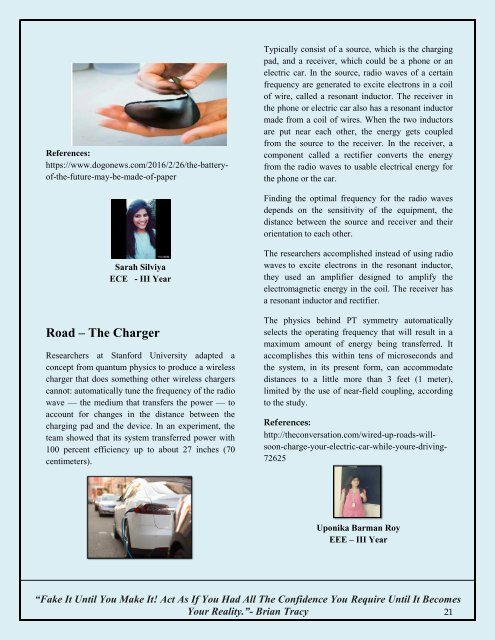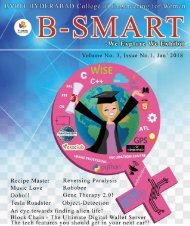B-Smart_July'17
Create successful ePaper yourself
Turn your PDF publications into a flip-book with our unique Google optimized e-Paper software.
References:<br />
https://www.dogonews.com/2016/2/26/the-batteryof-the-future-may-be-made-of-paper<br />
Typically consist of a source, which is the charging<br />
pad, and a receiver, which could be a phone or an<br />
electric car. In the source, radio waves of a certain<br />
frequency are generated to excite electrons in a coil<br />
of wire, called a resonant inductor. The receiver in<br />
the phone or electric car also has a resonant inductor<br />
made from a coil of wires. When the two inductors<br />
are put near each other, the energy gets coupled<br />
from the source to the receiver. In the receiver, a<br />
component called a rectifier converts the energy<br />
from the radio waves to usable electrical energy for<br />
the phone or the car.<br />
Finding the optimal frequency for the radio waves<br />
depends on the sensitivity of the equipment, the<br />
distance between the source and receiver and their<br />
orientation to each other.<br />
Sarah Silviya<br />
ECE - III Year<br />
Road – The Charger<br />
Researchers at Stanford University adapted a<br />
concept from quantum physics to produce a wireless<br />
charger that does something other wireless chargers<br />
cannot: automatically tune the frequency of the radio<br />
wave — the medium that transfers the power — to<br />
account for changes in the distance between the<br />
charging pad and the device. In an experiment, the<br />
team showed that its system transferred power with<br />
100 percent efficiency up to about 27 inches (70<br />
centimeters).<br />
The researchers accomplished instead of using radio<br />
waves to excite electrons in the resonant inductor,<br />
they used an amplifier designed to amplify the<br />
electromagnetic energy in the coil. The receiver has<br />
a resonant inductor and rectifier.<br />
The physics behind PT symmetry automatically<br />
selects the operating frequency that will result in a<br />
maximum amount of energy being transferred. It<br />
accomplishes this within tens of microseconds and<br />
the system, in its present form, can accommodate<br />
distances to a little more than 3 feet (1 meter),<br />
limited by the use of near-field coupling, according<br />
to the study.<br />
References:<br />
http://theconversation.com/wired-up-roads-will-<br />
soon-charge-your-electric-car-while-youre-driving-<br />
72625<br />
Uponika Barman Roy<br />
EEE – III Year<br />
“Fake It Until You Make It! Act As If You Had All The Confidence You Require Until It Becomes<br />
Your Reality.”- Brian Tracy<br />
21





